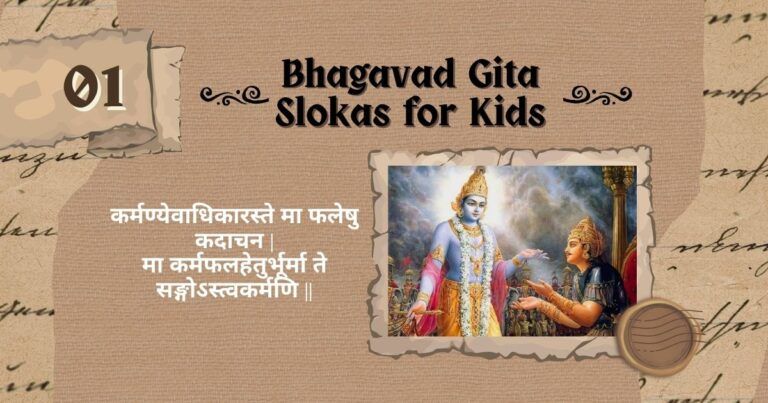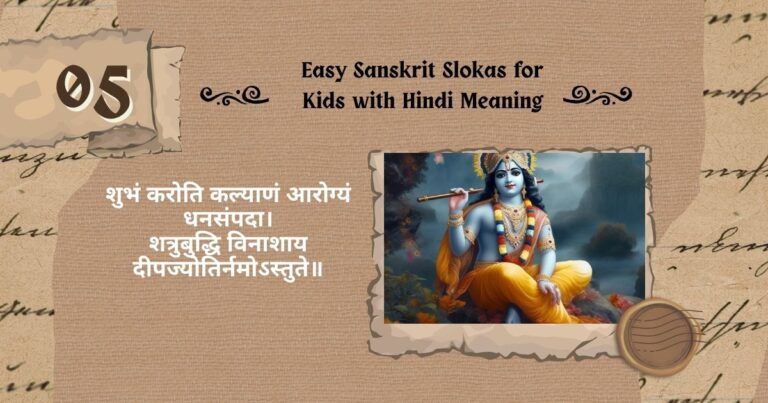Bhagavad Gita Slokas for Kids

अशोच्यानन्वशोचस्त्वं प्रज्ञावादांश्च भाषसे |
गतासूनगतासूंश्च नानुशोचन्ति पण्डिता: ||
Asochyaananvashochastvam prajnyavadansh bhaashse.
Gātāsūngātāsūncha Nanushochanti Pandita:
The Supreme Lord said: While you speak words of wisdom, you are mourning for that which is not worthy of grief. The wise lament neither for the living nor for the dead.
न त्वेवाहं जातु नासं न त्वं नेमे जनाधिपा |
न चैव न भविष्याम: सर्वे वयमत: परम् ||
Na tvevaham jatu nasan na tvam neme janadhipa.
Na Chaiva Na Bhavishyam: Sarve Vayamat: Param
Never was there a time when I did not exist, nor you, nor all these kings; nor in the future shall any of us cease to be.
मात्रास्पर्शास्तु कौन्तेय शीतोष्णसुखदु: खदा: |
आगमापायिनोऽनित्यास्तांस्तितिक्षस्व भारत ||
mātrā-sparśhās tu kaunteya śhītoṣhṇa-sukha-duḥkha-dāḥ
āgamāpāyino ’nityās tans-titikṣhasva bhārata
O son of Kunti, the contact between the senses and the sense objects gives rise to fleeting perceptions of happiness and distress. These are non-permanent, and come and go like the winter and summer seasons. O descendent of Bharat, one must learn to tolerate them without being disturbed.
यं हि न व्यथयन्त्येते पुरुषं पुरुषर्षभ |
समदु:खसुखं धीरं सोऽमृतत्वाय कल्पते ||
Ya hi na vyathayantyete purusham purusharshabha
समदुःखसुखं दीरं सोऽमृत्त्वाय कल्पते
O Arjun, noblest amongst men, that person who is not affected by happiness and distress, and remains steady in both, becomes eligible for liberation.
सुखदु:खे समे कृत्वा लाभालाभौ जयाजयौ |
ततो युद्धाय युज्यस्व नैवं पापमवाप्स्यसि ||
sukha-duḥkhe same kṛitvā lābhālābhau jayājayau
tato yuddhāya yujyasva naivaṁ pāpam avāpsyasi
Fight for the sake of duty, treating alike happiness and distress, loss and gain, victory and defeat. Fulfilling your responsibility in this way, you will never incur sin.
भोगैश्वर्यप्रसक्तानां तयापहृतचेतसाम् |
व्यवसायात्मिका बुद्धि: समाधौ न विधीयते ||
Bhogaishwaryaprasaktanaan tayapahritchetsam |
Business mind: Samadhau na vidhiyate ||
With their minds deeply attached to worldly pleasures and their intellects bewildered by such things, they are unable to possess the resolute determination for success on the path to God.
कर्मण्येवाधिकारस्ते मा फलेषु कदाचन |
मा कर्मफलहेतुर्भूर्मा ते सङ्गोऽस्त्वकर्मणि ||
Karmanyevadhikaraste ma phaleshu kadachan. |
Maa Karmaphalheturbhurma te Sangostvakarmani ||
In the Bhagavad Gita, Lord Krishna tells Arjuna – You only have a right to action (karma) and not to the fruits of your karma. Do not become a person who constantly meditates upon (gets attached to) the results of one’s karma. Do not get attached to inactivity (no karma).
योगस्थ: कुरु कर्माणि सङ्गं त्यक्त्वा धनञ्जय |
सिद्ध्यसिद्ध्यो: समो भूत्वा समत्वं योग उच्यते ||
Yogastha: Kuru Karmani Sangam Tyktva Dhananjay |
Siddhyasiddhyo: Samo bhootva samatvam yoga uchyate ||
Be steadfast in the performance of your duty, O Arjun, abandoning attachment to success and failure. Such equanimity is called Yog.
ध्यायतो विषयान्पुंस: सङ्गस्तेषूपजायते |
सङ्गात्सञ्जायते काम: कामात्क्रोधोऽभिजायते ||
dhyāyato viṣhayān puṁsaḥ saṅgas teṣhūpajāyate
saṅgāt sañjāyate kāmaḥ kāmāt krodho ’bhijāyate
While contemplating on the objects of the senses, one develops attachment to them. Attachment leads to desire, and from desire arises anger.
क्रोधाद्भवति सम्मोह: सम्मोहात्स्मृतिविभ्रम: |
स्मृतिभ्रंशाद् बुद्धिनाशो बुद्धिनाशात्प्रणश्यति ||
krodhād bhavati sammohaḥ sammohāt smṛiti-vibhramaḥ
smṛiti-bhranśhād buddhi-nāśho buddhi-nāśhāt praṇaśhyati
Anger leads to clouding of judgment, which results in bewilderment of memory. When memory is bewildered, the intellect gets destroyed; and when the intellect is destroyed, one is ruined.
यज्ञार्थात्कर्मणोऽन्यत्र लोकोऽयं कर्मबन्धन: |
तदर्थं कर्म कौन्तेय मुक्तसङ्ग: समाचर ||
Yagyarthatkarmano’nyatra loko’yam karmabandhan: |
Tadartha Karma Kaunteya Muktsangah Samachar ||
Work must be done as a yajna to the Supreme Lord; otherwise, work causes bondage in this material world. Therefore, O son of Kunti, for the satisfaction of God, perform your prescribed duties, without being attached to the results.
यज्ञशिष्टाशिन: सन्तो मुच्यन्ते सर्वकिल्बिषै: |
भुञ्जते ते त्वघं पापा ये पचन्त्यात्मकारणात् ||
Yagyashishthashin: Santo Muchyante Sarvakilbishai:
Bhunjate te tvagham papa ye pachantyatkaarnaat ||
The spiritually-minded, who eat food that is first offered in sacrifice, are released from all kinds of sin. Others, who cook food for their own enjoyment, verily eat only sin.
अन्नाद्भवन्ति भूतानि पर्जन्यादन्नसम्भव: |
यज्ञाद्भवति पर्जन्यो यज्ञ: कर्मसमुद्भव: ||
Annadbhavanti bhootani parjanyadannasambhavah. |
Yagyadbhavati Parjanyo Yagya: Karmasamudbhava: ||
All living beings subsist on food, and food is produced by rains. Rains come from the performance of sacrifice, and sacrifice is produced by the performance of prescribed duties.
यद्यदाचरति श्रेष्ठस्तत्तदेवेतरो जन: |
स यत्प्रमाणं कुरुते लोकस्तदनुवर्तते ||
yad yad acarati shrestha tat tad evetaro janah |
sa yat pramanam kurute lokas tad anuvartate ||
You should also perform your work to set an example for the good of the world. Whatever actions great persons perform, common people follow. Whatever standards they set, all the world pursues.
मयि सर्वाणि कर्माणि संन्यस्याध्यात्मचेतसा |
निराशीर्निनर्ममो भूत्वा युध्यस्व विगतज्वर: ||
mayi sarvani karmani sannyasyadhyatma-chetasa
nirashir nirmamo bhutva yudhyasva vigata-jvarah
Performing all works as an offering unto Me, constantly meditate on Me as the Supreme. Become free from desire and selfishness, and with your mental grief departed, fight!
काम एष क्रोध एष रजोगुणसमुद्भव: ||
महाशनो महापाप्मा विद्ध्येनमिह वैरिणम् ||
kama esha krodha esha rajo-guna-samudbhavah
mahashano maha-papma viddhyenam iha vairinam
The Supreme Lord said: It is lust alone, which is born of contact with the mode of passion, and later transformed into anger. Know this as the sinful, all-devouring enemy in the world.
यदा यदा हि धर्मस्य ग्लानिर्भवति भारत |
अभ्युत्थानमधर्मस्य तदात्मानं सृजाम्यहम् ||
yada yada hi dharmasya glanir bhavati bharata
abhyutthanam adharmasya tadatmanam srijamyaham
Whenever there is a decline in righteousness and an increase in unrighteousness, O Arjun, at that time I manifest Myself on earth.
परित्राणाय साधूनां विनाशाय च दुष्कृताम् |
धर्मसंस्थापनार्थाय सम्भवामि युगे युगे ||
Paritraṇaya sadhunaṃ viṇasaya cha duṣkṛtam.
Dharmasthanarthay Sambhavami Yuge Yuge || 8||
To protect the righteous, to annihilate the wicked, and to reestablish the principles of dharma I appear on this earth, age after age.
वीतरागभयक्रोधा मन्मया मामुपाश्रिता: |
बहवो ज्ञानतपसा पूता मद्भावमागता: ||
vita-raga-bhaya-krodha man-maya mam upashritah
bahavo jnana-tapasa puta mad-bhavam agatah
Being free from attachment, fear, and anger, becoming fully absorbed in Me, and taking refuge in Me, many persons in the past became purified by knowledge of Me, and thus attained My divine love.
ये यथा मां प्रपद्यन्ते तांस्तथैव भजाम्यहम् |
मम वर्त्मानुवर्तन्ते मनुष्या: पार्थ सर्वश: ||
Ye yatha maa prapadyante taanstathaiva bhajamyham. |
Mam vartmanuvartante manushaah partha sarvasah ||
In whatever way people surrender unto Me, I reciprocate accordingly. Everyone follows My path, knowingly or unknowingly, O son of Pritha..
Read Also – Mantra for Kid
FAQ,S
Frequently Asked Questions
How to introduce Bhagavad Gita to kids ?
Introduce the Bhagavad Gita to kids through engaging stories from the Mahabharata, focusing on its teachings of duty, righteousness, and inner peace. Use simple language, relate its lessons to everyday life, and encourage questions to deepen their understanding and connection to its timeless wisdom.
What are the key messages in the Bhagavad Gita for kids ?
1. **Duty and Righteousness (Dharma)**: Teachings emphasize the importance of doing one’s duty with dedication and integrity, regardless of the outcome.
2. **Inner Strength and Resilience**: It encourages developing inner strength and resilience to face challenges bravely, as seen in Arjuna’s dilemma on the battlefield.
3. **Equality and Respect**: The Gita promotes treating everyone with equality and respect, emphasizing that all beings are interconnected.
4. **Self-Control and Discipline**: It teaches the importance of self-control and discipline in thoughts, words, and actions.
5. **Devotion and Faith**: Emphasizes the power of devotion (bhakti) and faith in guiding one’s actions and finding inner peace.
6. **Knowledge and Wisdom**: Advocates seeking knowledge and wisdom as pathways to understanding oneself and the world around.
What is written in Bhagavad Gita for students ?
1. **Focus on Learning**: It encourages students to dedicate themselves wholeheartedly to their studies and acquire knowledge with diligence.
2. **Duty and Responsibility**: Emphasizes the importance of fulfilling one’s duties and responsibilities conscientiously, whether in studies or other aspects of life.
3. **Maintaining Equanimity**: Teaches the importance of maintaining mental balance and equanimity, especially during challenging times like exams or decision-making.
4. **Seeking Guidance**: Advises seeking guidance from wise and knowledgeable mentors (Gurus) to gain clarity and direction in life’s pursuits.
5. **Balancing Material and Spiritual Life**: Encourages a balanced approach to life, integrating material goals with spiritual growth and ethical conduct.
6. **Importance of Action (Karma Yoga)**: Advocates performing one’s duties selflessly and without attachment to the results, emphasizing the process rather than just the outcome.
7. **Self-Development**: Promotes self-development through introspection, self-discipline, and the pursuit of excellence in all endeavors.
Sanskrit Slokas for Kids

Guru Brahma Shloka:
Guru Brahma, Guru Vishnu, Guru Devo Maheshwara Guru Sakshat, Param Brahma, Tasmai Shri Guruve Namah
Saraswati Vandana:
Saraswati Namastubhyam, Varade Kamarupini Vidyarambham Karishyami, Siddhir Bhavatu Me Sada
Gayatri Mantra:
Om Bhur Bhuvah Swaha, Tat Savitur Varenyam Bhargo Devasya Dheemahi, Dhiyo Yo Nah Prachodayat
Shanti Mantra:
Om Sahana Vavatu, Sahanau Bhunaktu Sahaveeryam Karavavahai Tejasvinavadhitamastu Ma Vidvishavahai Om Shanti Shanti Shantihi
Ganesh Vandana:
Vakratunda Mahakaya, Surya Koti Samaprabha Nirvighnam Kurume Deva, Sarva Karyeshu Sarvada
Maha Mrityunjaya Mantra:
Om Tryambakam Yajamahe Sugandhim Pushtivardhanam Urvarukamiva Bandhanan Mrityor Mukshiya Maamritat
Krishna Shloka:
Vasudeva Sutaṁ Devaṁ Kaṁsa Chāṇūra Mardhanam Devakī Parama Anandaṁ Kṛiṣhṇaṁ Vande Jagad Guruṁ
Shiva Shloka:
Om Namah Shivaya
Laxmi Shloka:
Sarva Mangala Mangalye, Shive Sarvaartha Saadhike Sharanye Trayambake Gauri, Narayani Namostute
Vishnu Shloka:
Shantakaram Bhujaga Shayanam, Padmanabham Suresham Vishwadharam Gagana Sadrisham, Megha Varnam Shubhangam Lakshmi Kantam Kamala Nayanam, Yogibhirdhyanagamyam Vande Vishnum Bhava Bhayaharam, Sarva Lokaika Natham
Hanuman Shloka:
Manojavam Maruta Tulya Vegam, Jitendriyam Buddhimataam Varistham
Vaataatmajam Vaanara Yootha Mukhyam, Shree Raama Dootam Sharanam Prapadye
Durga Shloka:
Ya Devi Sarva Bhuteshu, Shakti Rupena Samsthita Namastasyai Namastasyai, Namastasyai Namo Namah
Surya Shloka:
Om Mitraya Namaha
Narayan Shloka:
Narayanam Namaskritya, Naram Chaiva Narottamam Devi Saraswatim Vyasam, Tato Jayamudhirayet
Shani Shloka:
Om Sham Shanaishcharaya Namah
Rama Shloka:
Shree Raama Raama Raameti, Rame Raame Manorame Sahasra Nama Tattulyam, Raama Nama Varanane
Gita Shloka:
Karmanye Vadhikaraste, Ma Phaleshu Kadachana Ma Karma Phala Hetur Bhurmatey Sangostva Akarmani
Buddha Shloka:
Buddham Sharanam Gachchami Dhammam Sharanam Gachchami
Sangham Sharanam Gachchami
Ramayana Shloka:
Valmike Munisimhasya Kavite VanacharinahShrunvan Raama Kathanaam Kona Yanti Param Gatim
Veda Shloka:
Agni Meele PurohitamThese shlokas are easy to memorize and provide foundation for further learning in Sanskrit.
FAQ,S
Frequently Asked Questions
What is the shlok in Sanskrit for daily routine?
“यत्र योगेश्वरः कृष्णो यत्र पार्थो धनुर्धरः।
तत्र श्रीर्विजयो भूतिर्ध्रुवा नीतिर्मतिर्मम।।”
This verse is from Chapter 18, Verse 78 of the Bhagavad Gita. It translates to:
“Wherever there is Krishna, the Lord of Yoga, and wherever there is Arjuna, the supreme archer, there will also surely be prosperity, victory, happiness, and sound morality.
What is the mantra for children studying?
तत्सवितुर्वरेण्यं
भर्गो देवस्य धीमहि
धियो यो नः प्रचोदयात्॥
This mantra is from the Rigveda (3.62.10) and is dedicated to the Sun God (Savitri). It translates to:
“Om, let us meditate on the glory of the divine Light of the Sun,
May that Light enlighten our intellect.”
Which mantra increases focus?
ॐ गं गणपतये नमः
Here’s a breakdown of its meaning:
- Om: The universal sound, representing the essence of consciousness.
- Gam: The seed syllable representing Lord Ganesha.
- Ganapataye: Another name for Ganesha.
- Namaha: I bow down to you.
Shanti Mantra

This is the first Shanti mantra; it’s a good shloka for kids. It’s meaningful and also easy to chant. The Shanti Mantra is a prayer of peace from the Upanishads.
Asatoma sad gamaya
Tamaso ma jyotir gamaya
Mrityor ma amritam gamaya
Om shanti, shanti, shanti hi
Meaning: Lead me to truth from ignorance, lead me to light from the darkness, lead me to immortality from death. Let there be peace.
Om sahana vavatu sahanau bhunaktu
Sahaveeryam karavavahai
Tejas vinavati tamastu ma vidhwishavahai
Om shanti shanti shanti hi
Meaning: May God protect us both, the teacher and the student, on our journey towards attaining knowledge. May He nourish us. May we work together with great energy. May our studies be enlightening and brilliant. May there be no hate or hostility among us. Let there be peace in me, in nature, and in the divine force.
Om sarveshaam swastir bhavatu
Sarveshaam shantir bhavatu
Sarveshaam poornam bhavatu
Sarveshaam mangalam bhavatu
Sarve bhavantu sukhinah
Sarve santu niraamayaah
Sarve bhadraani pashyantu
Maakaschit duhkha bhaag bhavet
Meaning: May auspiciousness, peace, and prosperity be unto all. May everybody be happy and free from disabilities. May all strive for the good of others, and none suffer from sorrow.
Mooshika Vaahana Mantra
This mantra is for invoking the blessings of Lord Ganesha, who helps to eliminate obstacles in life.
Mooshika vahana modaka hasta
Chamara karna vilambita sootra
Vamana roopa Maheswara putra
Vighna vinayaka paada namaste
Meaning: Salutations to the Lord Ganesha, who has a mouse for a vehicle and a modak in his hand. Your ears are like big fans and you wear a sacred thread. You’re short in stature and the son of Lord Maheshwara (Shiva). I bow to you Lord Ganesha, the remover of all obstacles.
Guru Mantra
This mantra highlights the importance of teachers and equates them with the Hindu Trinity of Lord Brahma, Lord Vishnu and Lord Mahesh.
Gurur brahmah gurur vishnu
Gurur devo maheshwaraha
Gurur saakshaat param brahmah
Tasmai shree guravey namaha
Meaning: The guru (teacher) is the living representative of the Holy Trinity in Hinduism – Lord Brahma, Lord Vishnu, and Lord Shiva. The teacher is the representative of the Supreme Being. He gives me knowledge and destroys ignorance. I salute such a guru.
Saraswathi Namasthubhyam Mantra
This shloka invokes the blessings of the Goddess Saraswati, the Hindu Goddess of learning and wisdom.
Saraswati namastubhyam varade kaamaroopini
Vidyaarambham karishhyaami siddhirbhavatu me sadaa
Meaning: Revered Goddess Saraswati, I prostrate before you as you are the one who can fulfil all my wishes. I am beginning my studies and ask you to bestow your grace upon me so that I am successful in my endeavour.
Manojavam Mantra
This shloka invokes the blessings of Lord Hanuman.
Mano javam maruda thulya vegam
Jithendriyam buddhi maatham varishtam
Vathaatmajam vanara yudha mukhyam
Sree rama dootham charanam prapadhye
Meaning: I take refuge in Lord Hanuman. I pray and salute the one who is as fast as thought, is more powerful than the wind, has mastered his senses, is the wisest, is the son of the Wind God, is the commander of the monkey brigade, and Lord Ram’s messenger. I bow at your feet.
Gayatri Mantra
The Gayatri Mantra, also called Savitri Mantra, is a Vedic chant from the Rig Veda. It is dedicated to the sun. Make your child recite it while standing under the early morning sun.
Om bhur bhuva swaha
Tat savitur varenyam
Bhargo devasya dhimahi
Dhiyo yo nah prachodayat
Meaning: We meditate on the glory of the vivifying Sun, whose divine light illuminates all realms – the physical, the mental and the spiritual. May your divine light illuminate our intellect.
FAQ,S
Frequently Asked Questions
Why is om Shanti chanted 3 times?
Completeness and Balance: In many spiritual practices, repeating a chant three times symbolizes completeness and balance. It signifies the expression of the chant in its entirety, reinforcing its meaning and intent.
Body, Speech, and Mind: In Hindu philosophy, the number three represents the triad of creation, preservation, and destruction, as well as the realms of existence: the physical, the astral (subtle), and the causal (spiritual). Chanting “Om Shanti” three times may symbolically purify these realms of existence—body, speech, and mind—bringing peace to all aspects of one’s being.
Invoke Blessings: Repetition is often used to invoke blessings or to enhance the power of the chant. By chanting “Om Shanti” thrice, practitioners may seek to deepen their connection with peace and invite its presence into their lives more profoundly.
Tradition and Ritual: In many rituals and prayers, certain chants or mantras are prescribed to be repeated a specific number of times. Three is a common number in many spiritual practices due to its symbolic importance and association with completeness.
What is the chant for peace?
When chanted together, “Om Shanti” invokes a deep sense of peace and tranquility. It is often repeated multiple times during meditation, prayers, and spiritual rituals to bring about inner calmness and to wish peace for all beings.
Other chants and mantras for peace from different spiritual traditions include:
Shalom: A Hebrew word meaning peace, used in Jewish prayers and greetings.
Salaam: An Arabic word meaning peace, used in Islamic prayers and greetings.
Pax Vobiscum: Latin for “peace be with you,” used in Christian liturgy.
Om Mani Padme Hum: A Tibetan Buddhist mantra that embodies compassion and invokes blessings and peace.
As-Salaamu Alaikum: An Islamic greeting meaning “peace be upon you.”
Which mantra removes negative thoughts?
One of the mantras known for dispelling negative thoughts and promoting inner peace and positivity is the “Shanti Mantra.” The most famous Shanti Mantra comes from the Brihadaranyaka Upanishad, one of the oldest Upanishads in Hindu scriptures. It is often chanted to invoke peace and harmony:
Om Asato Ma Sadgamaya
Tamaso Ma Jyotirgamaya
Mrityor Ma Amritamgamaya
Om Shanti Shanti Shanti
Guravey Sarva Mantra

This is a mantra in praise of the Dakshinamoorthy (Lord Shiva).
Guravey sarva lokaanaam
Bishajey bhava rohinaam
Nidhaye sarva vidyanaam
Shree dakshinaa moorthaye namaha
Meaning: We bow to the universal guru who is the teacher of the entire world and the healer of all diseases.
Vidyaarthee Shloka
This shloka can be recited while bowing to Lord Ganesha and praying to him to bless you with knowledge, a child, or salvation.
Vidyaarthee lapathey vidyaam
Dhanaarthee lapathey dhanam
Puthraarthee lapathey puthraan
Mokshaarthee lapathey gathim
Meaning: Aspire for knowledge, you’ll get it; yearn for wealth, you’ll get it; ask for a child, you’ll get it; strive for salvation, and you’ll reach it.
This sloka is about seeking Lord Ganesha’s blessings for removing obstacles in your path to success.
Vakrathunda mahaakaaya
Suryakoti samaprabha
Nirvignam kurumey deva
Sarvakaryeshu sarvada
Meaning: Lord with a curved trunk and huge body, and the brilliance of a million suns, I seek your blessings to grace my new beginning and remove all the obstacles as I begin to work.
FAQ,S
Frequently Asked Questions
How do you pray to Dakshinamurthy?
Preparation: Find a quiet and clean place for your prayers. You may set up an altar with a picture or idol of Dakshinamurthy, along with some flowers, incense, and a lamp.
Purification: Before beginning the prayers, purify yourself by washing your hands and feet. This ritual purification helps in focusing the mind and creating a sacred atmosphere.
Invocation: Begin by chanting the following mantra to invoke the blessings of Dakshinamurthy:
- Om Dakshinamurtaye Namaha This mantra venerates Dakshinamurthy and can be repeated mentally or aloud as you focus on the form or image of Dakshinamurthy.
Offerings: Offer flowers, light incense, and a lamp (diya) while praying. Offerings symbolize your devotion and gratitude towards Dakshinamurthy.
Prayers and Meditation: Offer your prayers sincerely from the heart. You can pray for knowledge, wisdom, guidance, and the removal of ignorance (avidya). Reflect on Dakshinamurthy as the embodiment of supreme knowledge and spiritual enlightenment.
Chanting: You may chant the Dakshinamurthy stotra or hymn, such as the Dakshinamurthy Ashtakam, which praises Dakshinamurthy’s attributes and teachings.
Silent Contemplation: After chanting or prayers, sit quietly and meditate upon the form of Dakshinamurthy. Absorb the qualities of wisdom, silence, and tranquility associated with Dakshinamurthy.
Closing: Conclude your prayers with gratitude. You can offer a final prayer or chant, such as:
- Om Shanti Shanti Shanti This mantra invokes peace and harmony.
Distribution of Prasad: If you have offered any food or sweets as prasad (divine offering), distribute it among family members or consume it as a blessed food.
How to worship Lord Dakshinamurthy at home?
Purification: Wash your hands and feet before you start the worship. This purifies the body and mind.
Invocation: Begin by chanting the Dakshinamurthy mantra:
- Om Dakshinamurtaye Namaha Chant this mantra while focusing on the form or picture of Dakshinamurthy.
Offerings:
- Light the lamp and incense. The lamp symbolizes removing darkness (ignorance) and spreading light (knowledge).
- Offer fresh flowers to the idol or picture of Dakshinamurthy.
- Offer water for washing the feet (padhya), water for washing the hands (arghya), and water for sipping (achamaniya).
Prayers and Hymns:
- Recite Dakshinamurthy Stotra or hymns like Dakshinamurthy Ashtakam, which praise Lord Dakshinamurthy’s qualities and teachings.
- Offer your prayers from the heart, seeking knowledge, wisdom, and spiritual guidance.
Meditation and Contemplation:
- Sit quietly and meditate upon the form of Dakshinamurthy. Reflect on the meaning of knowledge and silence that Dakshinamurthy signifies.
- Contemplate on the teachings of Dakshinamurthy and how they can guide your life towards spiritual growth.
Closing:
- Conclude the worship with gratitude and a final prayer.
- Ring the bell if you have one, signifying the completion of the worship and spreading the sound vibrations.
Distribution of Prasad:
- Distribute the prasad among family members or consume it as blessed food.
Can we keep Dakshinamurthy photo in pooja room?
Yes, you can definitely keep a photo or an idol of Dakshinamurthy in your pooja room at home. Here are some considerations and practices you can follow:
Placement: Place the photo or idol of Dakshinamurthy on a clean and elevated platform or altar in your pooja room. Ensure that it is placed facing either east or west, as these are considered auspicious directions for worship.
Cleanliness: Keep the area around the Dakshinamurthy photo or idol clean and tidy. Dust the idol or photo regularly and maintain the purity of the space.
Offerings: Offer flowers, incense, and a ghee lamp (or oil lamp) during your prayers and worship. These offerings symbolize devotion and reverence towards Dakshinamurthy.
Daily Worship: Perform daily prayers and rituals with sincerity and devotion. You can chant the Dakshinamurthy mantra (“Om Dakshinamurtaye Namaha”) and recite Dakshinamurthy Stotra or hymns during your worship sessions.
Respect: Treat the photo or idol with respect and reverence. Avoid placing it on the ground or in disrespectful places.
Intentions: While worshiping Dakshinamurthy, focus on seeking knowledge, wisdom, and spiritual guidance. Reflect on the teachings and symbolism associated with Dakshinamurthy.
Easy Sanskrit Slokas for Kids with Hindi Meaning

Saraswati Vandana
सर्वे भवंतु सुखिनः सर्वे संतु निरामयाः।
सर्वे भद्राणि पश्यंतु मा कश्चिद् दुःखभाग्भवेत्॥
Hindi Meaning: सभी सुखी हों, सभी रोगमुक्त हों। सभी मंगलमय घटनाएं देखें, कोई भी दुःखी न हो।
Guru Mantra
गुरुर्ब्रह्मा गुरुर्विष्णुः गुरुर्देवो महेश्वरः।
गुरुः साक्षात् परब्रह्म तस्मै श्रीगुरवे नमः॥
Hindi Meaning: गुरु ब्रह्मा हैं, गुरु विष्णु हैं, गुरु देव महेश्वर हैं। गुरु साक्षात् परब्रह्म हैं, ऐसे गुरु को नमस्कार है।
Gayatri Mantra
ॐ भूर्भुवः स्वः तत्सवितुर्वरेण्यम्।
भर्गो देवस्य धीमहि धियो यो नः प्रचोदयात्॥
Hindi Meaning: उस प्रजापालक देवता के तेजस्वी प्रकाश को हम धारण करें, जो हमारी बुद्धियों को प्रेरणा दे।
Shanti Mantra
ॐ सह नाववतु सह नौ भुनक्तु।
सह वीर्यं करवावहै तेजस्विनावधीतमस्तु मा विद्विषावहै॥
ॐ शान्तिः शान्तिः शान्तिः॥
Hindi Meaning: वह (ईश्वर) हम दोनों (गुरु और शिष्य) की रक्षा करें, हम दोनों का पोषण करें। हम दोनों मिलकर शक्ति प्राप्त करें, हमारा अध्ययन तेजस्वी बने। हम कभी एक-दूसरे से द्वेष न करें। ॐ शांति, शांति, शांति।
Laxmi Vandana
नमस्तेस्तु महामाये श्रीपीठे सुरपूजिते।
शंखचक्रगदाहस्ते महालक्ष्मि नमोऽस्तुते॥
Hindi Meaning: हे महामाया, श्रीपीठ पर विराजित, देवताओं द्वारा पूजित, शंख, चक्र और गदा धारण करने वाली महालक्ष्मी, आपको नमस्कार है।
Shubham Karoti
शुभं करोति कल्याणं आरोग्यं धनसंपदा।
शत्रुबुद्धि विनाशाय दीपज्योतिर्नमोऽस्तुते॥
Hindi Meaning: जो शुभ और कल्याणकारी है, आरोग्य और धन की प्राप्ति कराता है, शत्रु बुद्धि का नाश करता है, उस दीप की ज्योति को नमस्कार है।
Vakratunda Mahakaya
वक्रतुण्ड महाकाय सूर्यकोटि समप्रभ।
निर्विघ्नं कुरु मे देव सर्वकार्येषु सर्वदा॥
Hindi Meaning: टेढ़ी सूँड़ वाले विशालकाय, करोड़ सूर्यों के समान तेजस्वी हे प्रभु, मेरे सभी कार्यों को सदैव निर्विघ्न कर दें।
Twameva Mata
त्वमेव माता च पिता त्वमेव।
त्वमेव बंधुश्च सखा त्वमेव।
त्वमेव विद्या द्रविणं त्वमेव।
त्वमेव सर्वं मम देव देव॥
Hindi Meaning : आप ही मेरी माता और पिता हैं, आप ही मेरे बंधु और सखा हैं। आप ही मेरी विद्या और धन हैं, आप ही मेरे सब कुछ हैं, हे देव!
Karagre Vasate Laxmi
कराग्रे वसते लक्ष्मीः करमध्ये सरस्वती।
करमूले तु गोविन्दः प्रभाते करदर्शनम्॥
Hindi Meaning: हाथ के अग्रभाग में लक्ष्मी का वास है, हाथ के मध्यभाग में सरस्वती का निवास है और हाथ की मूल में गोविन्द का निवास है। प्रातःकाल हाथों के दर्शन से शुभ फल की प्राप्ति होती है।
Asato Ma Sadgamaya
असतो मा सद्गमय। तमसो मा ज्योतिर्गमय।
मृत्योर्मा अमृतं गमय॥
Hindi Meaning: हे प्रभु, मुझे असत्य से सत्य की ओर ले चलो, अंधकार से प्रकाश की ओर ले चलो, मृत्यु से अमरता की ओर ले चलो।
Om Namah Shivaya
ॐ नमः शिवाय।
Hindi Meaning: हे भगवान शिव, मैं आपको नमस्कार करता हूँ।
Om Shri Ganeshaya Namaha
ॐ श्री गणेशाय नमः।
Hindi Meaning: हे भगवान गणेश, मैं आपको नमस्कार करता हूँ।
Om Namo Bhagavate Vasudevaya
ॐ नमो भगवते वासुदेवाय।
Hindi Meaning: हे भगवान वासुदेव, मैं आपको नमस्कार करता हूँ।
Om Tryambakam Yajamahe
ॐ त्र्यम्बकं यजामहे सुगन्धिं पुष्टिवर्धनम्।
उर्वारुकमिव बन्धनान् मृत्योर्मुक्षीय माऽमृतात्॥
Hindi Meaning: हे भगवान त्र्यम्बक, हम आपकी पूजा करते हैं। आप हमें सुगंधित फूलों से युक्त करें, जैसे कि कच्चे अर्धबिंदु वाले भेड़ को फाड़ देते हैं, इसी प्रकार हमें मृत्यु के बंधन से मुक्ति प्रदान करें और अमृत की प्राप्ति करें।
Om Bhaskaraya Vidmahe
ॐ भास्कराय विद्महे महाधूताय धीमहि।
तन्नो सूर्यः प्रचोदयात्॥
Hindi Meaning: हे भास्कर (सूर्य) देवता, हम आपको जानते हैं, हम आपकी महाधूत (विद्युत) को धारण करते हैं। कृपया आप हमें अच्छे कार्य करने की प्रेरणा दें।
Om Shanti Shanti Shantihi
ॐ शान्तिः शान्तिः शान्तिः॥
Hindi Meaning: हे ईश्वर, हमें तीन प्रकार की शांति दें। (शारीरिक, मानसिक और आत्मिक)
Sarve Bhavantu Sukhinah
सर्वे भवन्तु सुखिनः।
सर्वे सन्तु निरामयाः।
Hindi Meaning: सभी सुखी हों। सभी रोगमुक्त रहें।
FAQ,S
Frequently Asked Questions
What is the Sanskrit slokas for daily life?
Gayatri Mantra:
- Om Bhur Bhuvaḥ Swaḥ
- Tat Savitur Vareṇyaṃ
- Bhargo Devasya Dhīmahi
- Dhiyo Yo Naḥ Prachodayāt
This mantra is dedicated to the Sun God and is considered one of the most powerful Vedic mantras. It is believed to bestow wisdom, spiritual enlightenment, and divine guidance.
Shanti Mantra (from Taittiriya Upanishad):
- Om Sahana Vavatu
- Sahanau Bhunaktu
- Saha Viryam Karavavahai
- Tejasvi Navadhitamastu
- Ma Vidvishavahai
What is the Sanskrit shlok for blessing?
ॐ सर्वे भवन्तु सुखिनः
सर्वे सन्तु निरामयाः ।
सर्वे भद्राणि पश्यन्तु
मा कश्चिद् दुःख भाग्भवेत् ।
ॐ शान्तिः शान्तिः शान्तिः ॥
Transliteration: Om Sarve Bhavantu Sukhinah
Sarve Santu Nirāmayāh |
Sarve Bhadrāṇi Paśyantu
Mā Kashiḍ Dukha Bhāgbhavet |
Om Shāntiḥ Shāntiḥ Shāntiḥ ||
Meaning:
- Om, may all beings be happy.
- May all beings be free from illness.
- May all see auspiciousness everywhere.
- May no one suffer from sorrow.
- Om, peace, peace, peace.
What is the Sanskrit shlok for happiness?
One of the Sanskrit shlokas (verses) that expresses the desire for happiness is as follows:
सुखं देहि केशवं सुखं देहि कृष्णाद्यमुष्मान् स्थितोऽसि विश्वं सुखेन सर्वं पूरय॥
Transliteration: Sukham Dehi Keshavam Sukham Dehi Krishnadyamushman sthito’si vishvam sukhena sarvam pooraya
